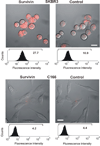Nano-flares: probes for transfection and mRNA detection in living cells
- PMID: 18034495
- PMCID: PMC3200543
- DOI: 10.1021/ja0776529
Nano-flares: probes for transfection and mRNA detection in living cells
Abstract
We demonstrate that novel oligonucleotide-modified gold nanoparticle probes hybridized to fluorophore-labeled complements can be used as both transfection agents and cellular “nano-flares” for detecting mRNA in living cells. Nano-flares take advantage of the highly efficient fluorescence quenching properties of gold, cellular uptake of oligonucleotide nanoparticle conjugates without the use of transfection agents, and the enzymatic stability of such conjugates, thus overcoming many of the challenges to creating sensitive and effective intracellular probes. Nano-flares exhibit high signaling, have low background fluorescence, and are sensitive to changes in the number of RNA transcripts present in cells.
Figures



References
-
- Tyagi S, Kramer FR. Nat. Biotechnol. 1996;14:303–308. - PubMed
- Sokol DL, Zhang XL, Lu PZ, Gewitz AM. Proc. Natl. Acad. Sci. U.S.A. 1998;95:11538–11543. - PMC - PubMed
- Peng X-H, Cao Z-H, Xia J-T, Carlson GW, Lewis MM, Wood WC, Yang L. Cancer Res. 2005;65:1909–1917. - PubMed
- Perlette J, Tan WH. Anal. Chem. 2001;73:5544–5550. - PubMed
- Nitin N, Santangelo PJ, Kim G, Nie SM, Bao G. Nucleic Acids Res. 2004;32:e58. - PMC - PubMed
-
- Santangelo P, Nitin N, Bao G. Annals of Biomedical Engineering. 2006;34:39–50. - PubMed
-
- Dubertret B, Calame M, Libchaber A. J. Nat. Biotechnol. 2001;19:365–370. - PubMed
Publication types
MeSH terms
Substances
Grants and funding
LinkOut - more resources
Full Text Sources
Other Literature Sources

